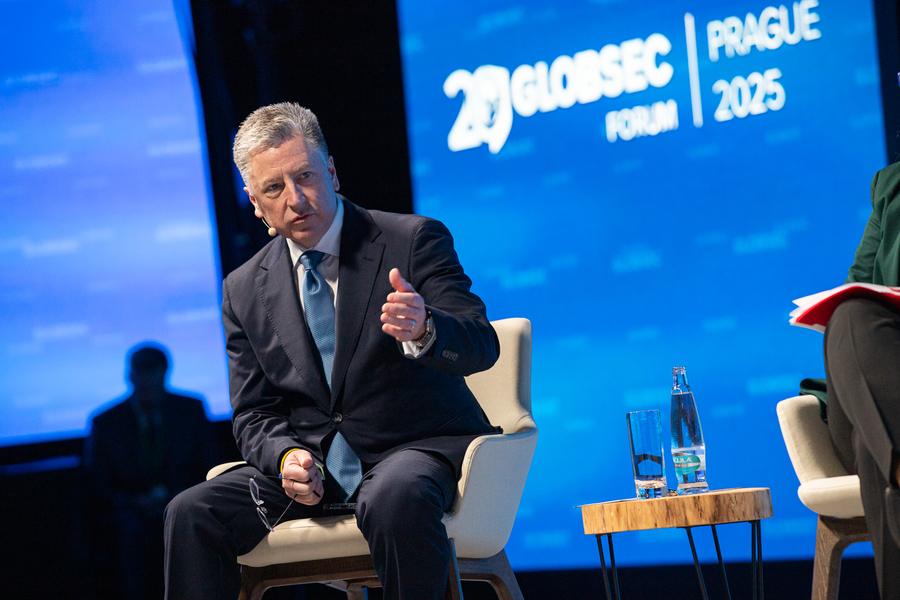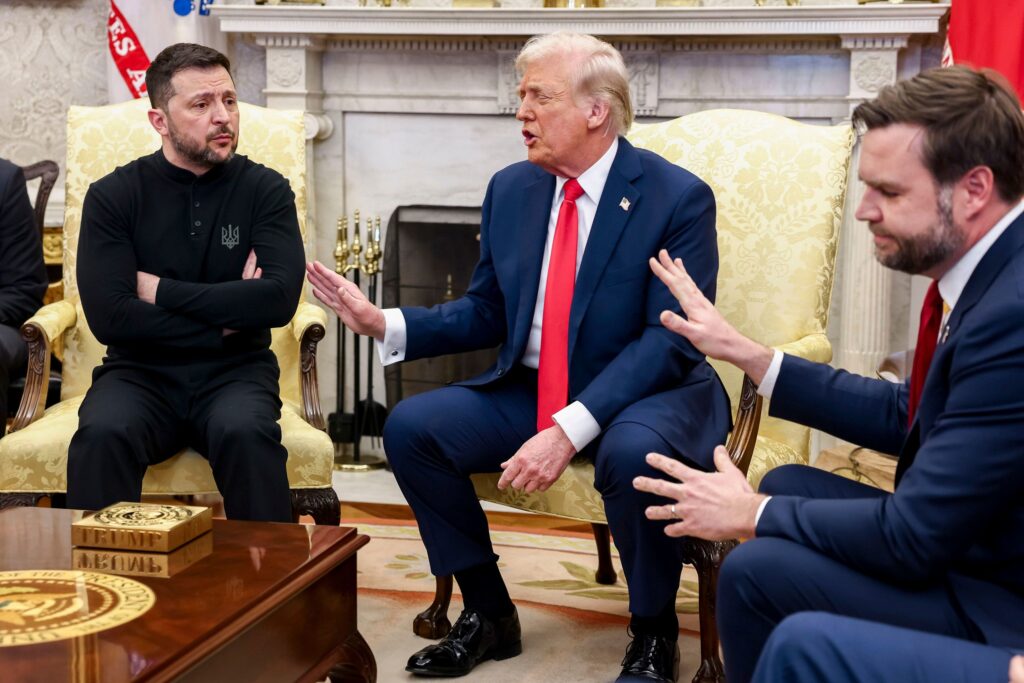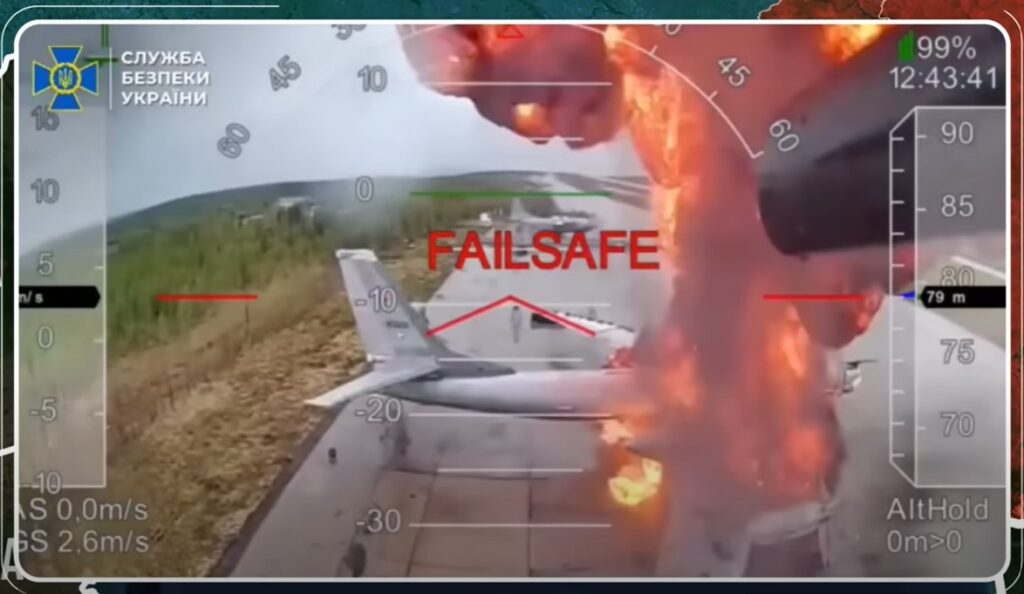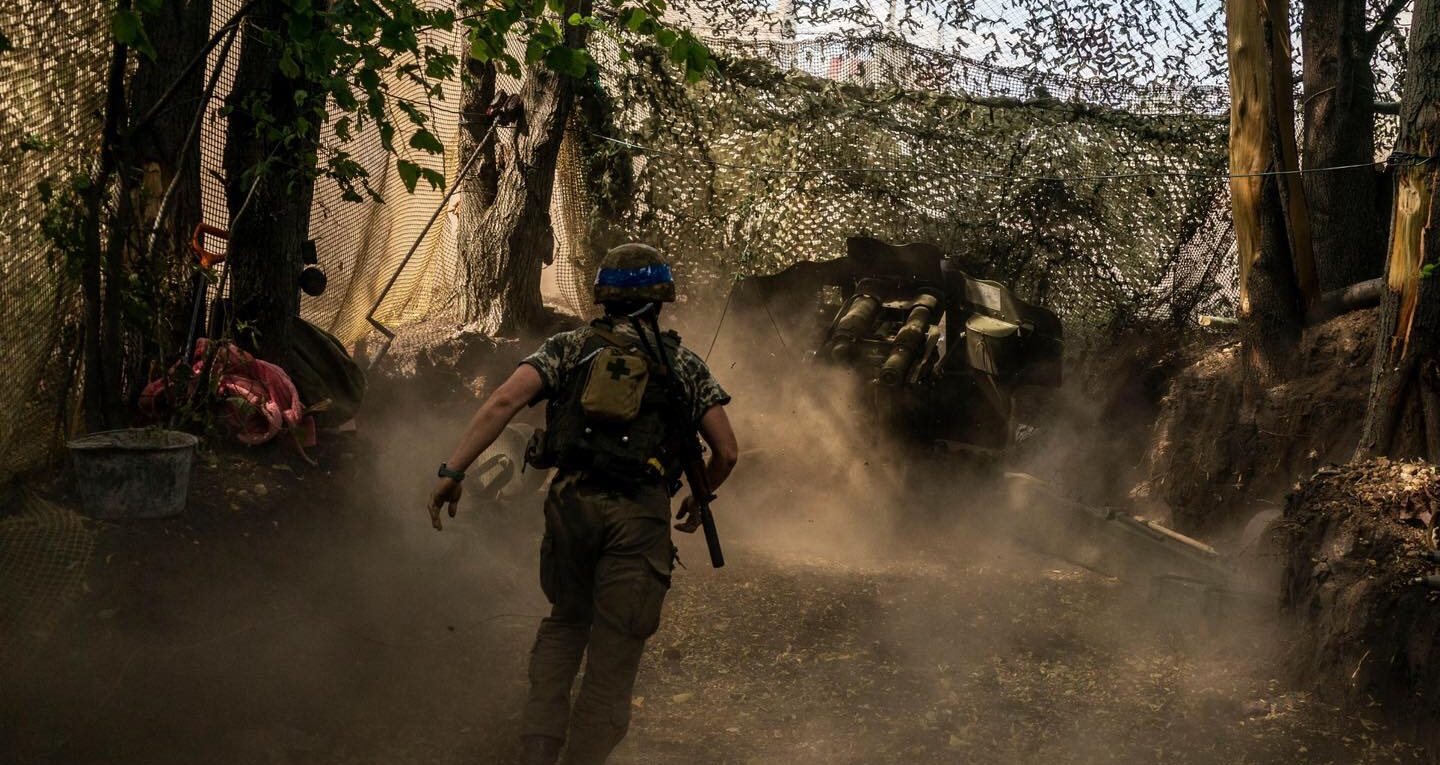At the GLOBSEC security conference in Prague, a senior European policy official delivered perhaps the most honest assessment of Western strategy heard in months. “I agree we are good at deterrence,” he told a packed room under Chatham House rules, “but even better at self-deterrence.”
The admission hung in the air like an uncomfortable truth no one wanted to acknowledge. Across three days of high-level panels at Europe’s premier security gathering, a stark pattern emerged: behind closed doors, experts candidly discussed how the West has abandoned the goal of Ukrainian victory, while public sessions featured sanitized rhetoric about “sustainable peace” and “ceasefire as a first step.”
The elephant in the room at GLOBSEC wasn’t Russian aggression or European unpreparedness—it was the quiet death of Ukraine’s victory narrative, and how Western self-deterrence killed it.

Frozen conflict Ukraine’s “best case scenario” because Russia has nukes, Kurt Volker says
The vanishing victory plan
The transformation has been swift and devastating. In 2022, Zelensky’s original peace plan demanded complete Russian withdrawal, war crimes tribunals, and reparations—the full accountability of total defeat.
On the eve of Trump’s election and Western talks of ceasefires, in October 2024, Zelensky presented his “Victory Plan” to Ukraine’s parliament. He called for complete Russian withdrawal, NATO membership, and positioning Ukraine to “force Russia to peace.” The rhetoric was still about total Russian defeat.
By June 2025, Ukrainian Foreign Minister Andriy Sybiha was singing a different tune at GLOBSEC’s main stage. “A real and lasting ceasefire is the first step to peace,” he declared, parroting the Trump administration’s desire to freeze and forget the war.
The Oval Office spat was the breaking point. On 28 February 2025, Trump told Zelensky bluntly: “you’re not winning this” and “you don’t have the cards right now.” When Ukraine initially resisted ceasefire proposals, the United States temporarily suspended aid. Within weeks, Kyiv had capitulated.

At GLOBSEC, this transformation was visible in real time. In panels operating under Chatham House rules, where officials could speak freely, the assessment was brutally honest. “I think we have helped Ukraine to defend itself, but we haven’t helped Ukraine to win,” the senior official observed. The problem?
“It was fear that if we did too much, Russia would act in a forceful manner that would involve us all.”
But when Ukrainian officials appeared on public panels, they dutifully promoted ceasefire proposals that experts acknowledge would lead to Ukrainian defeat, ensuring the freezing of a war that would allow Russia to rearm and reattack while continuing brutal human rights abuses on occupied lands.
How Russia’s nuclear threats became its ultimate weapon
The heart of the problem, as revealed in GLOBSEC’s frank discussions, is what a senior European foreign policy analyst called “a very well-laid information trap, which people who didn’t understand deterrence and didn’t understand Russia walked straight into.”
The information trap has a name—reflexive control. The technique, developed in the 1960s by Soviet mathematician Vladimir Lefebvre, is designed to trick opponents into making self-defeating decisions without realizing they’re being manipulated.
The Soviets perfected this during the Cold War through elaborate deceptions. They developed fake models of intercontinental ballistic missiles for participation in Red Square parades to create “an exaggerated impression on the American side of the shock potential of Soviet nuclear weapons,” as documented by Timothy Thomas in his seminal study of reflexive control theory.
The goal was to trick the West into wasteful spending on nonexistent threats while Soviet leaders knew their actual capabilities were far more limited.
The pattern is depressingly familiar today. Every Ukrainian weapons request—from Leopard tanks to ATACMS missiles to Taurus cruise missiles—faced identical Russian nuclear threats. None materialized.
Yet each time, Western officials delayed, debated, and ultimately provided too little, too late.
Ukraine’s Spider Web operation provided a perfect case study. In June 2025, Ukraine struck Russian strategic aviation bases, reportedly destroying one-third of Russia’s nuclear-capable bomber fleet. Where was Putin’s promised escalation? Where was the nuclear retaliation that had paralyzed Western decision-making for years?
“If you can hit the strategic strike force of a nuclear power without having the kind of retaliation that has been the nightmares of Olaf Scholz and Jake Sullivan, then it really is a lesson we should be learning,” the senior foreign policy analyst noted during one GLOBSEC discussion.

Modern Russia has refined reflexive control into a systematic assault on Western decision-making. As Ivana Stradner from the Foundation for Defence of Democracies explained during a closed-door GLOBSEC session, Russian analysts have long studied “how you can actually reflexively control the United States. That’s exactly what Moscow is doing right now in Europe.”
The technique operates through a precise three-part system: mathematical modeling combined with analysis of how you process information and how your enemy processes information.
As Stradner noted, “whoever has information superiority is going to win this war.”
The evidence against Russian nuclear blackmail was overwhelming, yet ignored. Ukraine had systematically crossed every supposed “red line”—striking the Kerch Bridge, sinking the Moskva flagship, occupying Russian territory in Kursk, destroying strategic aviation bases.
Each time, Putin’s threatened escalation failed to materialize. China would never tolerate Russian nuclear use that could trigger global retaliation affecting Chinese interests. And Putin himself, obsessed with personal survival and billion-dollar palaces, hardly fit the profile of a leader ready for nuclear suicide.
But the lesson wasn’t learned. As the senior European official pointedly asked: Russian “red lines”—”have you seen them work?” The answer was obvious to everyone in the room, yet Western policy remains captive to threats that existed only in imagination.

The West chose not to win
Ukrainian officials at GLOBSEC laid out the stark reality that Western leaders refused to acknowledge. “Unfortunately, we don’t have now enough power to do it on the battlefield. I have no doubt that our partners have this power,” explained Yehor Cherniev, deputy chairman of Ukraine’s National Security Committee. “Russian ability to wage war has two pillars: economy and the military capacity.”
The Ukrainian analysis was straightforward: Russia could be defeated through either military or economic pressure.
- On the military side, this meant providing sufficient weapons without restrictions and removing the artificial limitations that kept Ukraine fighting with one hand tied behind its back.
- On the economic side, it meant actually using the sanctions power and frozen assets that could cripple Russia’s war machine.
“There is so much space with the sanctions on their oil and gas, their metallurgy, their financial sector,” Cherniev continued. “And the Western world, you can do this and can put this burden much more on Russia’s economy. Without the financing, their army cannot move forward.”
The tragedy revealed at GLOBSEC was that the West chose neither path.
Instead of decisive military support, Ukraine received delayed, limited aid with restrictions that protected Russian territory. Instead of economic warfare using Russia’s own frozen assets, Europe debated legal niceties while taxing its own citizens for defense.
The West chose neither the economic, nor military path to help Ukraine achieve victory.
The means to victory existed; the will to use them did not.
“If we collectively in Europe realized that Ukraine’s victory is central, we wouldn’t be sitting here three and a half years in still not having won the war,” the senior foreign policy analyst admitted.
Kacper Rekawek from the International Centre for Counter Terrorism was more direct: “We chose not to win this. We, the West. Maybe we’re unable to because we have grown too lazy, too fat, too comfortable. And the ones who wanted to win this, generally for Ukraine and with Ukraine—the likes of Poland and the Baltics—just don’t have the bandwidth to push the others into thinking that this is a geopolitical struggle.”
Being lost is a rare chance:
“You have a once-in-a-hundred-years chance to proverbially kick some Russian ass. Last time was 1917, when they made a suicidal mistake. We just need to push them for suicide to actually happen.”
The resource paradox
The absurdity of Western defeatism becomes clear when examining the numbers.
- Europe’s economy is 12 times larger than Russia’s, its population four times greater.
- The frozen Russian assets alone—€300 billion of the aggressor’s own money sitting in European banks—could fund Ukrainian victory multiple times over.
- Combined European and American GDP dwarfs Russia’s by orders of magnitude.
Yet European leaders speak of “preparing for war by 2030” while refusing to use existing resources to prevent it. The clearest articulation of what was lost came from Olena Halushka of the International Center for Ukrainian Victory during GLOBSEC’s opening panel.
“If the goal is to help Ukraine survive, that’s one type of aid,” she explained. “If the goal is to help Ukraine win, that’s a whole other story about supporting and commitment.”
The clearest way to support Ukraine would be to use the frozen €300 bn of Russian funds for Ukrainian defense.
However, EU countries have not mustered the will for full confiscation, and only a fragment—€3.5 bn windfall profits from the €183 bn sitting in Belgium’s Euroclear—has been spent on helping Ukraine’s resistance in 2024. But starting from 2025, even these proceeds will not buy weapons for Ukraine; rather, they will be used to repay a €50 bn loan issued by the G7.
The West, Halushka argued, had unconsciously shifted from victory to survival mode. European leaders speak of preparing for war by 2030, of ramping up defense production over five to ten years. But, “the elephant in the room is that the best way to deter Russia from Russian aggression, wider Russian aggression, is to help Ukraine win.”
Instead, Europe is pursuing the worst of both worlds: preparing for direct confrontation with Russia while simultaneously abandoning the tools that could prevent it.
Ukrainian victory would eliminate the Russian threat to NATO’s eastern flank. Ukrainian defeat—disguised as a “frozen conflict”—guarantees future Russian aggression.
The expert consensus on current ceasefire proposals is damning. Every serious analyst who spoke at GLOBSEC warned that Trump’s approach would create a dangerous frozen conflict rather than lasting peace.
Historical precedent supports their pessimism: Russia has used identical tactics in the 2014-2015 Minsk process, designed to present an identical illusion of “peace.” The full-scale invasion followed in 2022.

Western decision paralysis enables broader aggression
Ukraine’s victory wasn’t just abandoned—it was sacrificed to a broader Western reluctance to confront authoritarian aggression. As the senior foreign policy analyst revealed during GLOBSEC discussions, Western intelligence communities exhibit “an inherent bias to be warning against the worst” with “a negative bias because that warning is seen as your job.”
“When nuclear war is at stake, you can understand the urge to caution. But actually, the result of that caution is a worse strategic situation that puts you in grave danger of another kind,” he revealed the working mechanism of nuclear decision paralysis.
The cost of this indecision becomes clear when examining current ceasefire proposals. Even tentative ceasefires and ensuing frozen conflict appear to be wishful thinking: Russia is not even interested in taking a breather, as it keeps making unacceptable demands for Ukraine to surrender regions it controls, without a fight.

Hi! My name is Alya Shandra, I’m the author of this piece. I believe in the power of data and analysis, and that’s why we try to give you the best of it at Euromaidan Press.
Become our patron to help us bring you the best insights from Ukrainian and foreign analysts so we can cut through the noise together.
“I’m surprised how many people are seriously hoping that something may come out of the process where the starting points are absolutely unacceptable. We are speaking about a whole new level of escalation where Russia can add into their constitution whatever they want: Suwalki, Narva, Svalbard, Dresden, whatever their lawmakers decide,” Olena Halushka stated bluntly.
This constitutional annexation strategy represents the ultimate weaponization of nuclear blackmail—allowing Russia to claim any territory simply by adding it to domestic law, then threatening global war if the world doesn’t comply.
“The international law rules-based world order is already destroyed,” Halushka continued, “but that would be a whole new level of destruction.”
Meanwhile, the West’s much-vaunted “coalition of the willing,” suffers from the same paralysis that enabled Russian success. Former Lithuanian Foreign Minister Gabrielis Landsbergis has repeatedly asked: “Coalition of the willing to do what? And coalition of the willing to do when?”
The initially enthusiastic Franco-British idea of putting EU boots on the ground is facing an uncertain future after failing to secure American backing. Or rather, because it was designed as a post-ceasefire deterrence force, while achieving this very same flawed ceasefire needs immediate deterrence
The consequences of this coalition paralysis are becoming increasingly stark. New GLOBSEC analysis assigns a 20% probability to “Hybrid World War III”—a scenario where multiple global conflicts blur international focus on Ukraine while Russian aggression spreads.
Ukrainian experts warn this represents the second most likely scenario after prolonged war of attrition, reflecting how Western indecision creates conditions for broader conflict escalation that the intelligence community’s excessive caution was supposedly designed to prevent.

GLOBSEC mapped seven Ukraine war scenarios through 2026. Even the “best case” spells future disaster.
The road not taken
GLOBSEC’s most sobering discussions focused on what victory could have looked like.
Ukraine has proven that “no safe place now in Russia” exists for military targets, demonstrating capabilities that have surprised even supporters. The country’s defense industry has scaled production 35-fold in some areas, developing drone and electronic warfare technologies that NATO militaries are eager to learn from.
“Ukraine is rewriting the rules of modern warfare,” as one Ukrainian official noted. The irony is palpable: the West abandoned victory just as Ukraine was demonstrating it was achievable.
Instead of leveraging these Ukrainian capabilities for decisive victory, Western policymakers chose managed stalemate.
The question left hanging in Prague’s corridors was stark: will Western leaders find the courage to align their policies with their private understanding before Russian nuclear blackmail succeeds permanently? Signs of awakening were visible—recognition that Europe faces an existential threat, not a regional conflict.
But with Ukraine already being pushed toward ceasefire negotiations and Russian forces entrenching in occupied territory, the window for course correction is rapidly closing.
The tragedy is that officials who privately know better continue to implement policies that, as they themselves admit, make the catastrophic war everyone fears far more likely. Whether private wisdom can overcome public cowardice before it’s too late remains the defining question of our time.
Read also
-
A guide to Russian propaganda. Part 5: Reflexive Control
-
Why freezing Ukraine’s war would guarantee another Russian invasion
-
The peace trap: Five ways Putin wins if Ukraine freezes the war
-
Russia’s “ultimate” red line is as hollow as the first ten
-
Russia’s thickest “red line” just went up in smoke — now the West has to go all in





